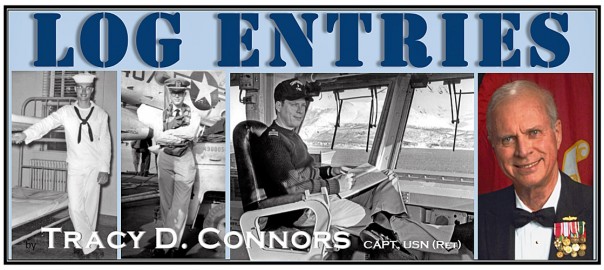
Author’s note: this “blog” was actually written in 1963 while I was the Asst. Navigator for the USS F. D. ROOSEVELT (CVA-42). It is dedicated to friends who also served in ROOSEVELT and have stood this same watch, including: Bill Brinkley, Paul Dickson and Steve Wood.
Shoes shined, lint off uniform, tie straight, buttons buttoned, cap cover clean, cigarettes, lighter, pencil, pen, gloves, hat brim polished—well, that’s it.
Now, for a cup of coffee to start the watch off right.
As the level of coffee drops lower and lower in the cup, I read the Plan of the Day that gives the watch schedules, announcements and events of interest to the crew. Especially I note what is going to happen on my watch.
I say “going to happen.” That’s not quite correct.
As the Officer of the Deck, I make it happen.
One of the duties of the OOD is to see that the routine in the PoD is carried out.
If I note an item that I do not believe should be carried, out, before changing it, I must notifiy the Executive Officer (XO).
The time has come, grab my hat, put on gloves, down the passageway, up the ladder and onto the hangar deck.
On my way forward I note the Chief (JOOD) has things well in hand on the after brow. We found that it ties up unnecessary officers to run the enlisted liberty parties when a chief petty officer could do the job just as well. This leaves the OOD free to run officer’s boating, general visiting, official visits, and the general administrative matters of the ship.
Into the Deck House noting the uniforms and shoe shines of the enlisted personnel.
There are five Sailors present for this watch.
The boatswains mate is in charge of military matters (e.g. announcements over the 1MC; general announcing system, pipe calls, running the enlisted watch here in the deck house, organizing side boys for official visits, etc.).
The Quartermaster keeps the rough deck log, noting times and events of importance that occur during the watch and doubling as boatswains mate from taps until reveille when the pipe calls are not needed.
A sound powered phone talker has communications with boat booms 1, 2, and 3, the after brow, the fantail and forecastle.
Two messengers are available to escort visitors, get hot coffee and rolls for the OOD and watch team, and run any needed errands. In addition, from 0800 to colors (at sunset) each evening, eight sideboys are on call on a bench outside the deckhouse, in case they might be needed for honors, tending the side, etc.
In the olden days they were on hand to keep high ranking officers from falling off ladders when landing from a pitching boat. Now, they are for appearances.
Read the message board, which contains items that the OOD needs to know (e.g. barge services, tug arrivals and departures, entrance and sortie plans, SOPA (Senior Officer Present Afloat) instructions, etc.
Then, read the PDL (Pass Down the Line), a small book in a green cloth cover that lists items of note concerning ship departures from standard practice or things that need special attention.
Next to read is the summary board. It contains the staus and whereabouts of all boats, whereabouts of the Captain, XO, Command Duty Officer, Assistant CDO, the duty officers of all squadrons, departments and key personnel and where they may be contacted.
© Tracy D. Connors 2015 All Rights Reserved
